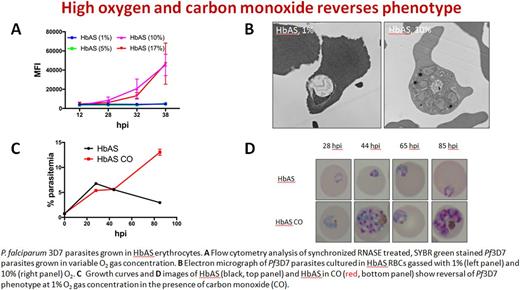Abstract
Background: Despite the global acceptance of Haldane's hypothesis that individuals with sickle cell trait (AS) are protected against malaria, an exact mechanism of resistance remains unknown. Several theories to explain the resistance such as increased splenic destruction, impaired hemoglobin digestion, reduced cytoadherence and specific translocation of host specific microRNAs have been proposed. Here we carefully examine the influence of hypoxia and its relation to parasite cytoadherence and growth in AS and normal (AA) human red blood cells (RBCs).
Materials and Methods: To assess the influence of oxygen tension on parasite proliferation in AS RBCs, we followed the proliferation of tightly synchronized P. falciparum within AS and AA RBCs at 1, 5, 10, and 17% oxygen by flow cytometry and microscopy. Carbon monoxide (CO) studies were performed by introducing 100% CO gas into our enclosed chamber system every 21 hours to prevent sickling at low oxygen.
Results: Flow cytometry assessment of DNA content confirms the absence of DNA replication within parasites in AS erythrocytes at low oxygen, however normal DNA replication is observed in the presence of high oxygen tension and when CO is introduced at low oxygen. Moving parasites from high to low oxygen tension greatly influences the extent of parasite maturity; parasites moved at 16 and 20 hours post invasion (hpi) do not mature beyond that of the late ring/early trophozoite stage while parasites moved at 24, 28, and 32 hpi develop increasingly more merozoites.
Conclusion: Here, we show that in hypoxic conditions parasites in AS erythrocytes stall at the late ring/early trophozoite stage and do not replicate their DNA. We also show that treatment of AS erythrocytes with high oxygen tension or carbon monoxide, a potent inhibitor of sickle hemoglobin polymerization, reverses this phenotype. We propose that the mechanism of AS protection is largely due to P.falciparum's inability to digest polymerized sickle hemoglobin once the parasite sequesters in the hypoxic microvasculature. This is likely a key driver of the reduced parasite densities observed in actual infections in AS individuals.
No relevant conflicts of interest to declare.
Author notes
Asterisk with author names denotes non-ASH members.


This feature is available to Subscribers Only
Sign In or Create an Account Close Modal